How to choose a filter for the pool: types of units and the rules for the right choice
The private pool on the site is a source of inexhaustible joy and good mood, as well as a place where you can relax after a busy day. But in order for it to remain clean, it is worth paying utmost attention to its arrangement. You must admit that untimely water treatment and its disinfection can turn the pool into a source of serious health hazard for swimmers.
To prevent this from happening, you need to be very responsible for the choice of equipment for water treatment. A properly selected filter for the pool will not only significantly improve water quality, but also save money on disinfection work. We will talk about methods of water treatment and what equipment is used for this purpose.
Useful recommendations on the selection of filtering equipment, as well as the advice of experienced professionals are presented in our article. And the presented photographs and videos will help you better understand how to independently conduct water purification in the pool.
The content of the article:
Water Filtration Options
Water circulation and the use of filter systems are the key to the quality work of any pool. According to the method of water intake, skimmer and overflow pools are distinguished. In each of them, water is taken for cleaning from the bottom and from the top.
In this case, the fence from the bottom is the same for each type of pool, and the fence from the surface is slightly different.
Option # 1 - water filtration in an overflow pool
Water splashing out of the bowl of the overflow pool falls into special drains, directing it first to the tank, and only then to the filtration.
The peculiarity of the pool is that the surface of the water is at the same level with the rim.The lion's share of pollution is initially located in the upper layer, so the dirtiest water gets into the drain.

If there is no movement in the pool, then there is no flow of water into the drain. In this regard, this cleaning scheme is ideal for stationary structures. It is not applicable for pool and inflatable pools.
Option # 2 - water filtration in a skimmer pool
Suction openings of stationary skimmer pools are located on the upper part of the walls. In frame and inflatable pools, skimmers are immersed to a shallow depth, hanging directly on the side.
The surface of the water with this method of sampling is located 0.2-0.3 m below the top of the side. The main disadvantage of this water extraction is that due to the low location of the nozzles, surface contamination is poorly removed.

No matter how efficient the surface cleaners work, some of the impurities in any case will fall to the bottom in the form of sediment. To remove sediment, it is necessary to ensure the selection of water from below and its supply to the filter.
The problem is solved by the construction of bottom drains, through which water is transported to filtering devices.
The number of water intake wall and bottom openings depends on the volume of water in the pool, the degree of contamination and the intensity of operation. In this case, the rule must be observed: 3 parts of water are supplied from the top to the filter, and 1 part from the bottom.
Bottom openings perform another important function - they provide full or partial drainage of water. This procedure is necessary for disinfection, mechanical cleaning of the walls, major work or conservation of the pool.
Option # 3 - cleaning with a filter unit
Water taken through skimmers and bottom holes is supplied to coarse filter, then under the action circulation pump moves for finer cleaning to the filtering station.
Also, the system may have a bacterial cleaning agent (ozonizer, chlorine generator, etc.), a device for heating water. After passing through all stages, purified and heated water is fed into the pool bowl.

The input zone of purified water is determined by the type of pool. In overflow varieties, injection zones are located at the bottom, and in skimmer ones, from the side opposite to the location of the skimmers. Such placement of injection zones provides better circulation of water and its uniform purification.
What to look for when choosing a filter?
The main criterion that should be followed when choosing a filter for the pool is the throughput. This value is calculated in liters or cubic meters of water, cleaned by the system per hour of operation.
With the help of modern filters for swimming pools, even microscopic inclusions can be eliminated, not to mention large particles. The degree of purification is determined by the filtration rate and the type of filter used.
At a lower speed, the maximum degree of water purification is ensured. In this case, the basic rule must be observed: the entire volume of water must pass through the filtration unit at least three times.
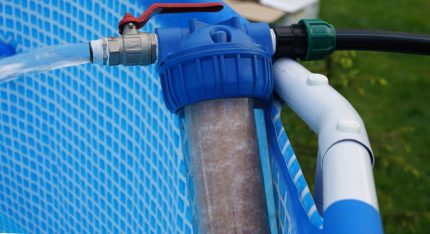
At choosing a pump It is necessary to focus on the volume of the pool.It should be borne in mind that an increase in the rate of passage of water through the filler leads to a decrease in the quality of treatment. Obviously, for a powerful pump, you need to select a filler with a large capacity.
Modern cleaning plants and filters are sold as a set, so there is no need to select a container for the pump or vice versa. Determining the filter performance is quite simple. To do this, the total volume of water in the pool must be multiplied by 2.5 and divided by 10.
For example, take a 10x4x4 pool that holds 80 tons of water. We calculate: 80x2.5 / 10 = 20 m3 / hour. The filtration unit for the pool should be selected based on the calculated capacity.
Types of Pool Filters
Depending on the material used for filtering, the following pool filters are distinguished:
- Mechanical;
- Chemical;
- Electrophysical;
- Combined.
Each of the presented filters can only partially solve the problem of water purification. That is why filtration systems consisting of several different types of filters have maximum efficiency.
No. 1 - mechanical filters for the pool
The following materials can be used as the filter element of mechanical filters:
- sand;
- woven or non-woven membrane;
- Activated carbon.
The principle of operation of a mechanical filter is quite simple - a membrane, layers of coal or sand, passing water through it, retain the lion's share of contaminants. The output is purified water, which has lost almost all impurities.
All pool filters that work on the principle of mechanical cleaning can be classified as follows:
- sand;
- cartridge;
- diatoms
This cleaning option is suitable for small pools up to 10 cubic meters. In large pools, in addition to mechanical cleaning, you will have to use a chemical one.
Sand Cleaning Filters
Sand-filled filters are the most affordable and simplest cleaning systems. As a rule, the filter consists of a closed plastic container with two openings designed for the entry and exit of water.
Most often, the tank is filled with quartz sand, which serves as a filter material.
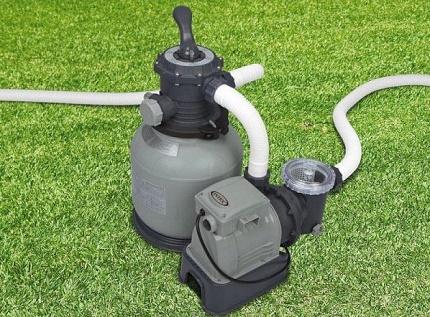
Organic impurities and mineral salts are easily trapped in the filter layer of silica sand. The same thing happens with chemical compounds that result from pool disinfection.
The disadvantage of this filter is the ability to retain particles not exceeding a size of 20 microns. Service life - no more than 3 years.
It is possible to increase the life of a sand filter to 5-6 years and increase the degree of water purification by replacing quartz sand with glass. Combined filling with a heterogeneous composition, in which alternating layers of gravel, gravel and sand are successively located, has proven itself even better.
The sand filter for the pool is easy to maintain; cleaning is carried out by flushing with a reverse pump.
Another advantage - the sand filter is easy to make with your own hands. The homemade assembly process is discussed in detail in this article.
Calcium deposits can be eliminated using special means introduced into the filter for several hours with the pump turned off. At the end, you need to carry out a standard washing procedure.
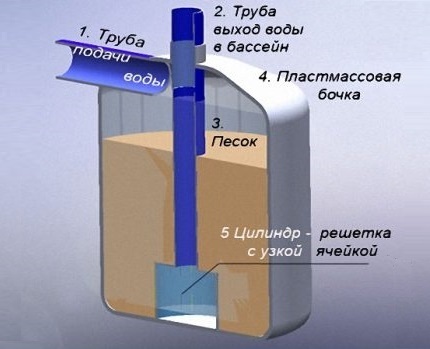
The low cost and ease of maintenance of the sand filter make it the most versatile and widely used pool owners. However, it also has significant drawbacks - high weight, impressive dimensions.
As an example, consider a sand filter with a Bestway pool pump.
Models from the same manufacturer may differ in design and function, so you must read the instructions before installation.
Actual prices for sand filters:
Cartridge filters for the pool
The role of the working element of this cleaning system is performed by the thinnest membranes made of propylene plates.
They successfully trap organic particles from 10 microns in size, mechanical salts and salts of mineral origin. The efficiency of water purification with a cartridge filter is almost double that of water purification with a sand filter.
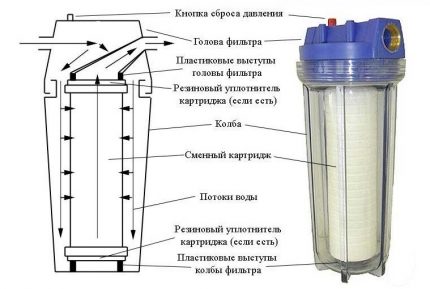
The cartridge filter is a box or flask with a hinged or removable lid, inside which a cartridge is installed. Also in the flask there is a small plastic bag designed to store filtered debris.
The main advantages of a cartridge filter:
- Compactness;
- High degree of water purification;
- Duration of operation;
- Lack of backwash function.
After contamination, the cartridge should be removed from the flask and rinsed. Depending on the volume of the pool, the life of the cartridge varies between 3-12 months. For effective operation of the cleaning system, you need to have a stock of several replaceable cartridges.
Often, modern cartridge filters are mounted in one housing of a portable cleaning system, hence another name for cleaning equipment comes from - filter pumps.
Despite the high degree of cleaning and ease of maintenance, cartridge filters are less popular sand filters, due to their greater cost.
Actual prices for cartridge filters:
Diatomite Cleaning Filters
Diatom (diatomite) filter is the most expensive among mechanical cleaning filters.
The role of the filtering element is diatomaceous powder, a siliceous sedimentary rock, composed of weakly compressed or slightly cemented hollow shells of ancient microorganisms and decomposition products of algae similar in age.
Before use, diatomite powder undergoes heat treatment - it is calcined in an oven at a temperature of 1200 degrees for at least a day.Such processing allows not only to eliminate all traces of organic matter, but also to obtain an excellent finely divided filter mixture of a uniform composition.
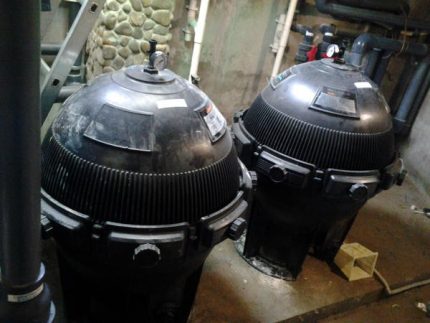
Diatom filters are available in two versions. In the first case, the filter device is similar to the sand aggregate device. The only difference is that instead of quartz or glass sand, a filling of diatom powder is used.
In the second case, the filtering unit is a system of cartridges sequentially located in one housing through which water is pumped. Such a device allows maximum purification of water, removing pollution from it, the dimensions of which are only 1-2 microns.
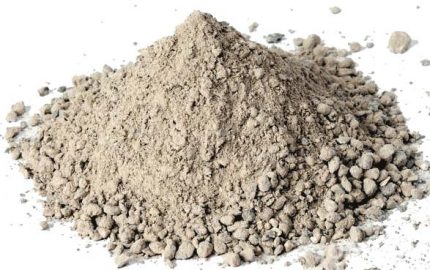
Due to the ability of diatom powder to enrich water with silicon, its use for cleaning can reduce the use of chemical cleaners by 75-80%.
As you know, silicon water has high healing and anti-aging qualities. That is why such expensive diatom filters effectively compete with cheap sand cleaning systems.
Actual prices for diatomite filters:
No. 2 - chemical water treatment
In chemical filtration, water is purified by exposure to reagents. Depending on the model of the filter, one to several cleaning operations can be performed.
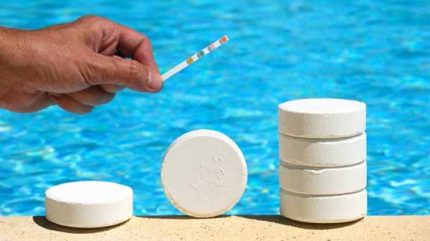
The greatest efficiency can be achieved with complex chemical filtration of water:
- chlorination;
- bromination;
- iodization.
Pool owners most often use chlorine as the bacterial protection - the cheapest and most effective disinfectant.
The main disadvantages of chlorine:
- unpleasant odor;
- causes allergies;
- does not destroy spore-forming microorganisms;
- able to create toxic compounds (chloramines and chloroform).
Despite a number of disadvantages, chlorine remains the most popular chemical water purifier. It quickly disappears, so after a few hours there is no trace left of it in the pool bowl, which means that there is an unpleasant smell and allergy. Toxic compounds are easily removed during complex cleaning.
In terms of cleaning efficiency, bromine is in no way inferior to chlorine. True, its cost is much higher, but there is no smell. With the right dosage, bromination of water is absolutely safe for humans.
In the process of cleaning with bromine, unpleasant odors are removed, bacteria, fungi and viruses are destroyed, the hardness of the water remains unchanged, high cleaning efficiency is achieved when the pH value of Ph deviates to a higher acid content or, conversely, alkali.
A special category of water purification chemicals is represented by special flocculant preparations. Their main task is to aggregate small pollutants and fat residues to sizes at which they can easily be captured by mechanical cleaning filters.
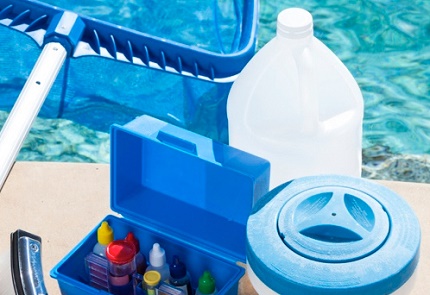
No. 3 - electrophysical cleaning filters
Electrophysical filters for cleaning pools have been used recently.
The main methods of electrophysical water purification in pools:
- ozonation;
- ultraviolet radiation;
- silver ionization;
- copper ionization.
Ozonation is considered one of the most progressive and environmentally friendly methods of water purification in the pool. Ozone has powerful oxidizing properties. When it passes through water, almost all bacteria are destroyed, while the composition of the water remains unchanged.
The main advantages of ozonation:
- the destruction of bacteria and microorganisms;
- elimination of unpleasant odor;
- saturation of water with oxygen.
The disadvantages of the cleaning system include the need for a special installation and its high cost. When water ozonation, the ozone concentration should not exceed 0.03 mg / m3, an overdose can be harmful to humans.
Since the effect of ozone on the human body has not been fully studied, water ozonation is prohibited in a number of countries.
Ultraviolet radiation is another way to effectively purify water, allowing you to completely abandon chemistry. When buying and installing an ultraviolet lamp, you need to consider that it only works effectively in purified water.

When processed with ultraviolet rays, water retains all its useful qualities, but the effect is short-lived.
The method of ultraviolet cleaning is recommended to be combined with another reagent, since after the cessation of radiation, microorganisms entering the water multiply intensively.
Today, water ionization is the most advanced purification method. Ions of copper and silver are released into the water by the action of electrodes, to which a weak current is supplied. Copper ions inhibit the growth of algae, and silver ions completely destroy viruses and bacteria.

Ionization of water has the following advantages:
- copper and silver ions remain active for a long time;
- when using an ionizer and an ozonizer together, you can opt out of chlorination;
- after ionization, the water meets the drinking standard;
- lack of allergic reactions and odor.
In addition, copper ions contribute to the bonding of the smallest particles (perform role of coagulant).
Disadvantages of water purification by ionization:
- poor combination with other disinfection methods;
- the impossibility of a complete rejection of chlorination in large pools;
- To date, the effect of metal ions on the human body has not been fully studied.
The greatest distribution in large basins is the combination of ionization with chlorination. You can refuse a chlorinator by replacing it with an ozonizer, but the combination “ozonation - ionization” is rarely used due to the high cost of equipment and significant energy consumption.
No. 4 - combined water filtration systems
Combined cleaning involves the installation of a whole system of filters and devices. When choosing combinations, the influence of cleaning methods on each other, reduction and increase in their effectiveness should be taken into account.
For example, a combination of ultraviolet radiation with the introduction of a solution of sodium hypochlorite, hydrogen peroxide or ozone works well.
The main steps to implement a comprehensive cleaning system for large pools:
- selection of primary and secondary pumps;
- installation of mechanical and chemical filters;
- installation of ionization, ozonation, UV;
- heat exchanger selection;
- preparation of premises for pumping equipment;
- complete set and assembly of the system.
It is important, when designing a complex filtration system, to carry out all the work before installing the pool. Otherwise, the laying of communications and connection will become much more complicated.
It is also important not to forget when designing to pay attention to organizing the right pool ventilation.

Sophisticated combined water filtration systems are used in large public pools of a stationary type. Only such systems prevent periodic drainage of water and mechanical cleaning of the bottom and walls pool.
You may also be interested in information on how to choose pool heat pump or how to choose best robot cleaner for automatic pool cleaning.
Conclusions and useful video on the topic
Overview of sand filter operating modes:
Disinfection of the pool with submersible UV lamps:
An effective way to keep pool water clean:
The choice of a filtration system must be approached very carefully, since the health of those who bathe in the pool depends on the quality of the water.
If a good mechanical type filter pump can solve the issue of water purification in a small home pool, then for large structures a whole system of filters and devices will be required.
Have you arranged a home pool on your site? Tell us which filter you use for water purification and are you satisfied with the result. Maybe you noticed inaccuracies or inconsistencies in this article? Write us about them in the comments section.

 Pool heat pump: selection criteria and installation rules
Pool heat pump: selection criteria and installation rules  How to choose a pump for the pool: a comparative overview of different types of units
How to choose a pump for the pool: a comparative overview of different types of units 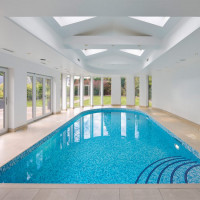 Organization of ventilation of the pool: the best methods of organizing air exchange
Organization of ventilation of the pool: the best methods of organizing air exchange 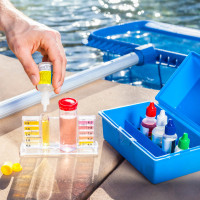 Coagulants for water purification in the pool: how to choose + application rules
Coagulants for water purification in the pool: how to choose + application rules  Do-it-yourself pool waterproofing: technology overview + step-by-step example of work
Do-it-yourself pool waterproofing: technology overview + step-by-step example of work 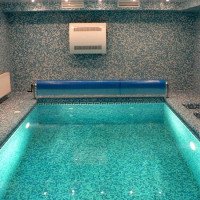 Dehumidifiers for pools: how to choose and calculate the optimal dehumidifier
Dehumidifiers for pools: how to choose and calculate the optimal dehumidifier  How much does it cost to connect gas to a private house: the price of organizing gas supply
How much does it cost to connect gas to a private house: the price of organizing gas supply  The best washing machines with dryer: model rating and customer tips
The best washing machines with dryer: model rating and customer tips  What is the color temperature of light and the nuances of choosing the temperature of the lamps to suit your needs
What is the color temperature of light and the nuances of choosing the temperature of the lamps to suit your needs  Replacement of a geyser in an apartment: replacement paperwork + basic norms and requirements
Replacement of a geyser in an apartment: replacement paperwork + basic norms and requirements
At the very beginning I used only chemical cleaning for the pool - periodically chlorinated water. Then the wife noticed that the children had a rash on the body and had to refuse from chlorination. We bought ultraviolet lamps for disinfection and put sand filters. I noticed that the water in the pool remains clean longer and there is no unpleasant smell from it.
We are going to install a swimming pool in a country house next year, so the topic is urgent. So far, we are also leaning towards the option with a sand filter. Let it be expensive, but of high quality. But sand filters for six to eight thousand, which can sometimes be seen in stores, are they good? Or is it a divorce for those who like to save?
Specifically, you can talk about the brand, sorry you did not specify it. Most likely you mean sand filters from Bestway or the like. Despite the low price, it is not necessary that they are bad. But, as with any “China”, much depends on banal luck. The same device of the same brand can work for 5-7 years without any complaints, and can break in a month.
What kind of manufacturer are you talking about? For 9-10 thousand rubles you can find quite good sand filters for the pool in terms of price / quality ratio. For example, the same Emaux P350 filter (4 m3 / h, D350) made in China has quite good build quality.
Of course, if it is possible to take more expensive equipment, especially European or American production, then it is better to make a choice in his favor.
For example, Hayward is a great solution, an American brand, but with facilities in China. If we compare Emaux and Bestway, then the choice is better to make in favor of the first, since the percentage of marriage is much less.
For several years I have been using the 3.6 by 1.22 frame pool and a simple cartridge filter, but in addition there is a “vacuum cleaner” and a trimmer. And also constantly pour peroxide. I do not change the water for three months of use.
One nuisance - I have already changed the filters 5 times over the years. They are short-lived, begin to “crackle and squeak”, fail. This year I want to install a sand filter, but the fact is that the diameter of the tubes is not suitable. You will have to cut home-made products to fasten the tubes for the filter pump or, apparently, buy additional fasteners.
From the installation video, I did not understand if they are included. Who bought these filters, please inform their configuration. Thanks in advance.